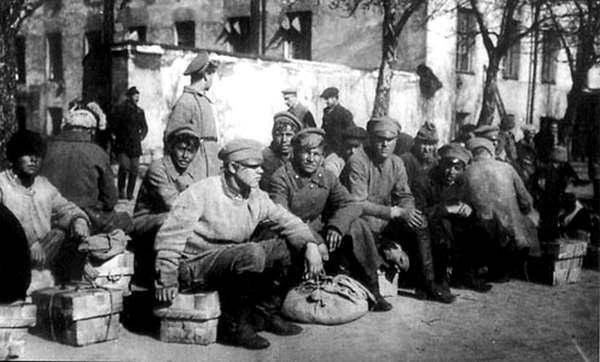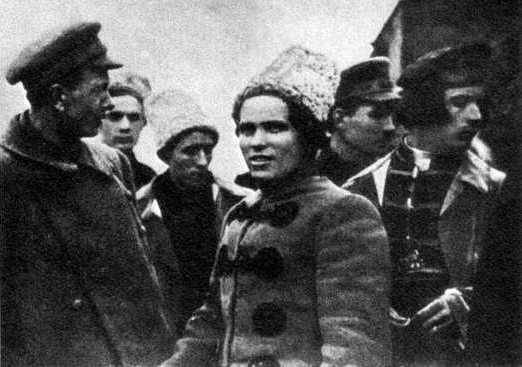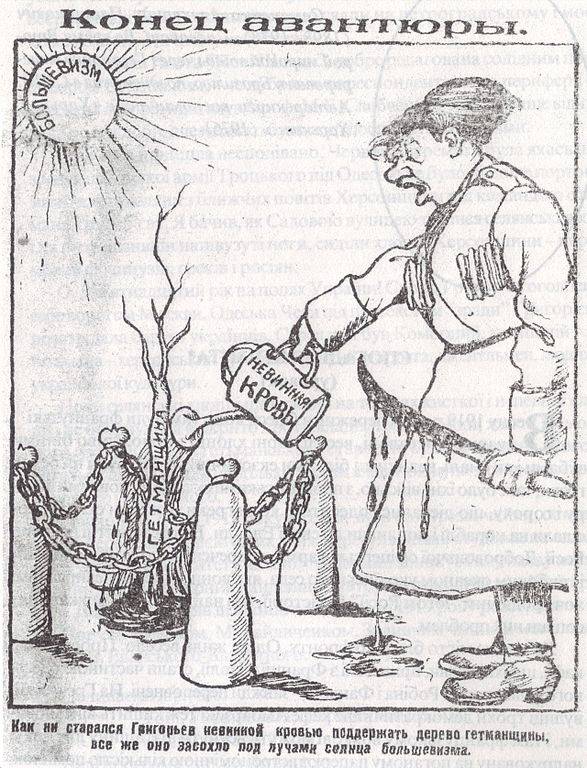How did the uprising of ataman Grigoriev

However, Grigoriev was not a great politician or commander, but only an ambitious adventurer. His ceiling was kompolka. During the “Russian distemper”, dozens and hundreds of such Grigorievs walked around Russia. Sometimes they thought of themselves as new Napoleons and for a short period achieved great popularity. But they lacked neither intelligence, nor education, nor an instinct to achieve more.
Background of the uprising in the Ukraine and New Russia
After the Reds occupied Kiev and Little Russia for the second time, and quite easily, as the people were tired of the hetman, interventionists and ataman, the situation in Ukraine soon heated again. The peasant war and the criminal revolution, which began in Little Russia with the beginning of the “troubles”, were only muffled for a while and soon burst into flames with a new force.
The growth of socio-political tensions in the south-western Russian region was triggered by the policy of "war communism." By the spring of 1919, the pro-Soviet sentiments of the Little Russian village were changing rapidly. The Council of People's Commissars of the Ukrainian SSR and the command of the Red Army tried to provide large-scale food supplies from the Ukraine (based on the surplus and grain monopoly) to the cities of central Russia. The problem was that a significant part of the past harvest and livestock had already been taken out by the Austro-German interventionists. As a result, the village was subjected to a new robbery.
An unpleasant for the peasants in addition to such a food policy was a new attempt at collectivization, which, in the conditions of the continuing civil and peasant war, was a clear “bend”. Such radical reforms require other conditions, peacetime. In March, 1919, the 3 All-Ukrainian Congress of Soviets was held in Kharkov, which adopted a resolution on the nationalization of the whole land. All the landowners' and kulak lands (and their share on the fertile lands of southern Russia was large), which were the main producers of agricultural products, passed into the hands of the state, and state farms and communes were created on their basis. However, in the conditions of revolution and unrest, the peasants have already made a “black repartition” of the landlord’s land, they also stole inventory, tools, and divided livestock. Hetman regime and the Germans tried to return the land to the owners, but met resistance. And after the overthrow of the Hetman the peasants again seized the land. And now they were going to take it away again. It is clear that this caused resistance, including armed. Began a new stage of the peasant war. The peasants did not want to return the land, give bread, serve in the army and pay taxes. A popular idea was the life of communities of free plowers.
The Bolsheviks did not stand on ceremony with the rebels. The county and frontal Cheka, Revolutionary Tribunals were active. A big problem was competent, honest cadres. Under the conditions of personnel shortage, many representatives of the Soviet government, the party, the Cheka and the Red Army themselves looked like murderers, robbers and rapists (some of them were). The Soviet authorities in the village often dispersed, were themselves punished, and, losing the support of the population, quickly decomposed. In the Soviet apparatus there was a big element of indifferent to all appointees, opportunists, careerists, "recoloured" enemies, declassed elements (lumpen) and frankly criminals. It is not surprising that drunkenness, theft and corruption flourished in the Soviet authorities (the whites in the rear had the same situation).
National-corporate groups began to form in the young Soviet state apparatus (which eventually will become one of the prerequisites for the collapse of the USSR). At the same time, there were many international cadres among Chekists, commissars, members of the Communist Party - Balts, Jews, Hungarians, Austrians, Germans (former prisoners of war of the Central Powers, who for various reasons remained in Russia), Chinese, etc. The international part of the uprising. Therefore, the surplus, punitive expeditions, the “Red Terror”, etc. were associated with foreigners. This caused a new surge of xenophobia and anti-Semitism, which had strong roots from the times of Polish rule.
The government of the Ukrainian SSR, the command of the Red Army also made a number of serious mistakes, failed to adequately respond to the development of negative trends. It was due to the need to ensure large deliveries of bread from the Ukraine to Central Russia; the struggle with the Donetsk group of whites in the east and the Petliurists in the west. In addition, Moscow was preparing for the “export of the revolution” to Europe. Yes, and with personnel in the government of the Ukrainian SSR was also bad.
Ataman
It is not surprising that as soon as the winter ended, the roads dried up and warmer, it became possible to spend the night in beams and forests, the peasants and gangsters again took up weapon. Again, in the Ukraine, detachments of various atamans and batteks (field commanders) began to walk, some were ideological - with a national color, leftists (but enemies of the Bolsheviks), anarchists, and others - outspoken gangsters. In broad daylight, gangsters robbed stores in cities. The very same elements that robbed Little Russia under the banner of Petliura, then went over to the side of the Red Army, and now again became “green”.
The fact was that the Directory regime was unable to create a regular army. The army of the Directory consisted mainly of partisan, semi-gangster formations, rebel peasants who fought with the interventionists and the Hetmanate troops. In the course of the offensive of the Red Army, these formations for the most part went over to the Reds. This was due to their low combat capability, they simply could not fight with the Red forces, as well as the growth of pro-Soviet sentiments in the village. As a result, the earlier rebel, Petlura units became part of the army of the Ukrainian SSR. At the same time, they retained their composition, commanders (atamans, troupes). In particular, among such detachments was the Kherson division "Ataman of the rebel forces of Kherson region, Zaporizhia and Tavria" N. A. Grigorieva. It became the 1-th Zadnipr Ukrainian Soviet Brigade, and then the 6-th Ukrainian Soviet Division. Grigorievtsy conducted active hostilities in the south of Little Russia.
At the same time, the new Soviet units retained the territorial principle, which tied them to a certain area, fed at the expense of the local population and retained their internal independence. The state supply of these units in the conditions of the collapse of the country's economy, and the commanders did not have the money allowance, or it was minimal. That is, financially motivate the fighters of such units and their commanders could not. These units still lived at the expense of trophies, requisition and outright looting, and used to live like that. In addition, many "Soviet" atamans continued to play an active political role, occupied administrative positions in county and volost authorities, participated in regional congresses of councils. Many Makhnovists, Grigorievtsy and former Petliurists continued to adhere to political movements hostile to the Bolsheviks - Ukrainian Left Social Revolutionaries, anarchists or nationalists.
The situation was complicated by the fact that there were a lot of weapons in Little Russia. It remained from the fronts of the world war — Russian and Austro-German, from the Austro-German invaders, from the western interventionists (mostly French), who quickly fled, leaving many weapons depots, from the fronts of the Civil War, which several times rolled over the south Western Russian regions.
Makhnovshchina
The most famous ataman was Makhno, under whose command was a whole army. His rebel army entered the Red Army as the 3-I Zadniprovsky brigade of the 1-y Zadneprovsky Ukrainian Soviet division. Then 7-I Ukrainian Soviet division. The Makhno brigade maintained internal autonomy and submitted to the red command only in operational terms. Makhno's troops controlled 72 volosts with a population of 2 million. Neither the Cheka detachments nor food detachments could enter this area; there was no collectivization there. It was a kind of “state within a state.” Makhno expressed disapproval of the decisions of the 3 All-Ukrainian Congress of Soviets on the nationalization of the land. The Makhnov’s program was based on the requirements of the “socialization” of the land (the transfer of land into the national property, which was the main part of the agrarian program of the Social Revolutionaries), as well as factories and mills; the abolition of the food policy of the Bolsheviks; rejection of the dictatorship of the Bolshevik Party; freedom of speech, press and assembly to all left-wing parties and groups; holding free elections to the Soviets of working peasants and workers, etc.
The farther away, the stronger were the frictions of Makhno with the Bolsheviks. 10 April in the Walk-field of the 3-th Congress of Makhnov district councils in its resolution qualified the policy of the Communists as "criminal against the social revolution and the working masses". The Kharkiv Council of Soviets was recognized as "not a true and free expression of the will of the working people." The Makhnovists protested against the policies of the Bolshevik government, commissars and emergency workers who shoot workers, peasants and insurgents. Makhno said that the Soviet government has changed the "October principles." As a result, the Congress ruled that it did not recognize the dictatorship of the Bolsheviks and against the "Commissar".
In response, Dybenko, in a telegram, called this congress "counter-revolutionary", threatened to declare the Makhnovists illegal. The Makhnovists responded with a protest and a statement that they were not afraid of such orders and they were ready to defend their people's rights. Only a little later, when Makhno met Antonov-Ovseenko, the situation was resolved. Makhno refused the most harsh statements.
In the middle of April 1919, the formation of the 2 of the Ukrainian Soviet Army from units of the Kharkov group of troops was completed. The Makhno brigade became part of the 7 of the Ukrainian Soviet division. However, the red command sharply reduced the supply of Makhno troops. Began to consider the issue of withdrawal of batko from the command of the brigade. There were demands: “Down with the Makhnovshchina!” However, it has not yet reached a complete break. In late April, Antonov-Ovsiyenko arrived in Gulyai-Polye with an inspection. Then, in early May, Kamenev arrived from Moscow. In the end, agreed.

The beginning of the uprising
Thus, the Red Army in Little Russia, heavily diluted by the rebel detachments, quickly decayed. In April - May, numerous violations are recorded in the army: pogroms, arbitrary requisition, looting, various atrocities, and even direct anti-Soviet revolts. In March - April, the most tense situation was in the central part of the Ukraine - Kiev, Poltava and Chernihiv provinces. In late April - early May, the situation deteriorates dramatically in Novorossia - Kherson, Elisavetgrad, and Nikolaev.
The situation was at its limit, all that was needed was a reason for a large-scale explosion. At the end of April 1919, the Council of People's Commissars adopted a decree that canceled the election of commanders. The 6 units of the Ukrainian Soviet division of Grigoriev, set aside for redevelopment into their native places of Kherson and Elizavetgrad, completely disintegrated and began to resist the actions of food detachments, the Soviet authorities. Communists began to kill.
The Red Command planned to send the 3 Ukrainian Army, which included the Grigoriev Division, to march on the assistance of Soviet Hungary. However, Grigoriev did not want to lead his troops to the front, in every way he avoided. 7 in May 1919, the commander of the 3 of the Ukrainian Soviet Army, Khudyakov ordered Grigoriev to stop the riots or lay down the powers of the divisional commander. The Chekists of the Special Department of the Army tried to arrest Grigoriev, but were killed. Seeing that further conflict can not be avoided, 8 May Grigoriev issued Universal "To the people of Ukraine and the Red Army soldiers", in which he called for a general uprising against the Bolshevik dictatorship in Ukraine.

To be continued ...
- Alexander Samsonov
- Smoot. 1919 year
How the British created the Armed Forces of the South of Russia
How to restore Soviet power in Ukraine
How Petliurists led Little Russia to a complete catastrophe
How defeated Petliurism
Give the boundaries of 1772 of the year!
Battle for the North Caucasus. How to suppress the Terek Uprising
Battle for the North Caucasus. CH 2. December battle
Battle for the North Caucasus. CH 3. The January accident of the 11 Army
Battle for the North Caucasus. CH 4. How the 11 army died
Battle for the North Caucasus. CH 5. Capture of Kizlyar and the Terrible
Battle for the North Caucasus. CH 6. Furious assault of Vladikavkaz
How Georgia tried to seize Sochi
How the Whites crushed the Georgian invaders
The war of February and October as a confrontation between two civilization projects
How did the "Flight to the Volga"
How Kolchak's army broke through to the Volga
Catastrophe of the Don Cossacks
Verkhniyon uprising
How "Great Finland" planned to seize Petrograd
"All to fight with Kolchak!"
Frunze. Red Napoleon
The missed opportunities of the army of Kolchak
May offensive of the Northern Corps
How white broke through to Petrograd
Battle for the South of Russia
Strategic change on the southern front. Manych operation
Crimea on fire Russian distemper
Crimea in 1918-1919. Intervents, local authorities and whites
Information